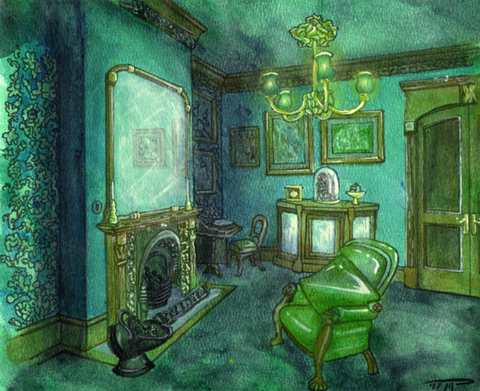Carl William Scheele is one of the most important scientists in human history, because of the sheer scale of his impact.
An incredibly prolific researcher, Scheele discovered oxygen, citric acid (also known as vitamin C), and chlorine gas. He developed a process for refining phosphorus that made his native Sweden into the world's leading supplier of matches. Like Prometheus with flame, his discoveries have paved the way for much of our modern world.
But Scheele also discovered something that caused untold pain, suffering and death for thousands of people for over a hundred years:
A beautiful, jewel-like shade of green.


Why was it so dangerous?
In the late 1700s, when Scheele and his colleagues were busy discovering new elements and filling in the periodic table, little was known about the toxic effects of these chemicals. Scheele himself died at age 43 of heavy-metal poisoning after spending his career handling, and even tasting, the new compounds he developed in his lab. Because there were no tests for this kind of poisoning, though, and because the effects often imitated other diseases like cholera, there were no safety measures - either for scientists or for the public.
Scheele himself did know how toxic his copper-arsenate compound - "Scheele's Green" - was. He discovered the pigment by accident, as part of his investigations into the nature of arsenic, and sought to warn other scientists about its toxicity. But Scheele died in 1785, and his warnings were lost to time... and to the great machinery of the Industrial Revolution, which saw his durable, versatile pigment only for its ecomonic potential.
And so Scheele's Green was used to dye everything. Clothing, wallpaper, bedding, faux foliage, children's toys -- even candy, on occasion, with deadly results. The Bradford Sweets Poisoning of 1858 led to the deaths of twenty children and the sickening of 200 others after arsenic was accidentally used to colour a batch of humbugs, a popular children's candy.

Wearing arsenic-laced clothing caused irritation of the skin, and breathing in the dust caused internal bleeding, gastrointestinal problems, and even cancer. But the pigment was beautiful, and what price beauty?
Perhaps the most high-profile victim of Scheele's Green was one Napoleon Bonaparte. During his exile on St Helena, Napoleon's walls were painted a bright apple-green - Scheele's pigment. Samples of his hair, analyzed by modern scientists, show very high levels of arsenic. As the walls became mouldy, the mould likely metabolized the arsenic salts, creating arsine gas. Napoleon's bitter and crumbling decline at the end of his life was likely caused as much by arsenic as by exile.
Although the dangers of Scheele's green were apparent by the mid-1800s, manufacturers continued to make and use it until the development of cobalt green in the late 19th century. And even when they were no longer used as pigments, arsenic-green compounds were used as pesticides and insecticides well into the 1940s.
What a beautiful, brilliant, jewel-coloured death those pests must have had, though.




Comments (3)
What a truly fascinating story! I’ve heard about the deaths associated with the wall paper, but not the backstory. So, this was interesting to learn about. What a shame the man died so young. & what a probably torturous death, too. So terrible his legacy was marred by the deaths of so many, including children. If there is an afterlife where we retain our consciousness, I’m sure he was devastated to learn what he unintendedly caused. & the parents of the children were probably horrified to learn that what they bought for the pleasure of their kids, stole them away. It’s noteworthy that humans who pursue monetary gain alone, haven’t learned this lesson, even now. Thank you.
Copper-arsenate is still a popular chemical in wood preservation today. We use Chromated Copper-Arsenate (CCA) to preserve wood that will be used for marine applications.
Vitamin C is actually Ascorbic acid, not citric.